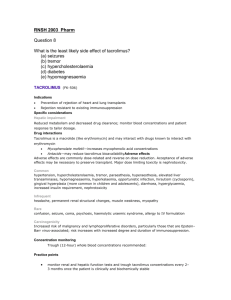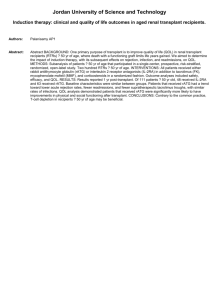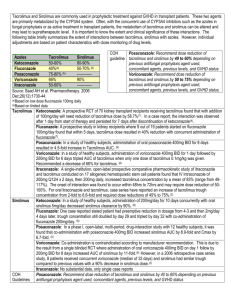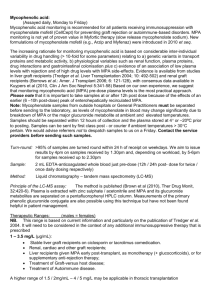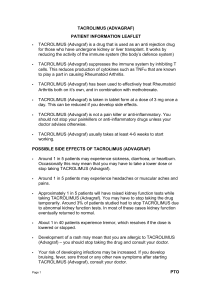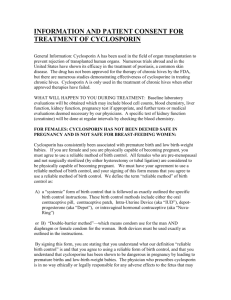LETTER - HAL
advertisement
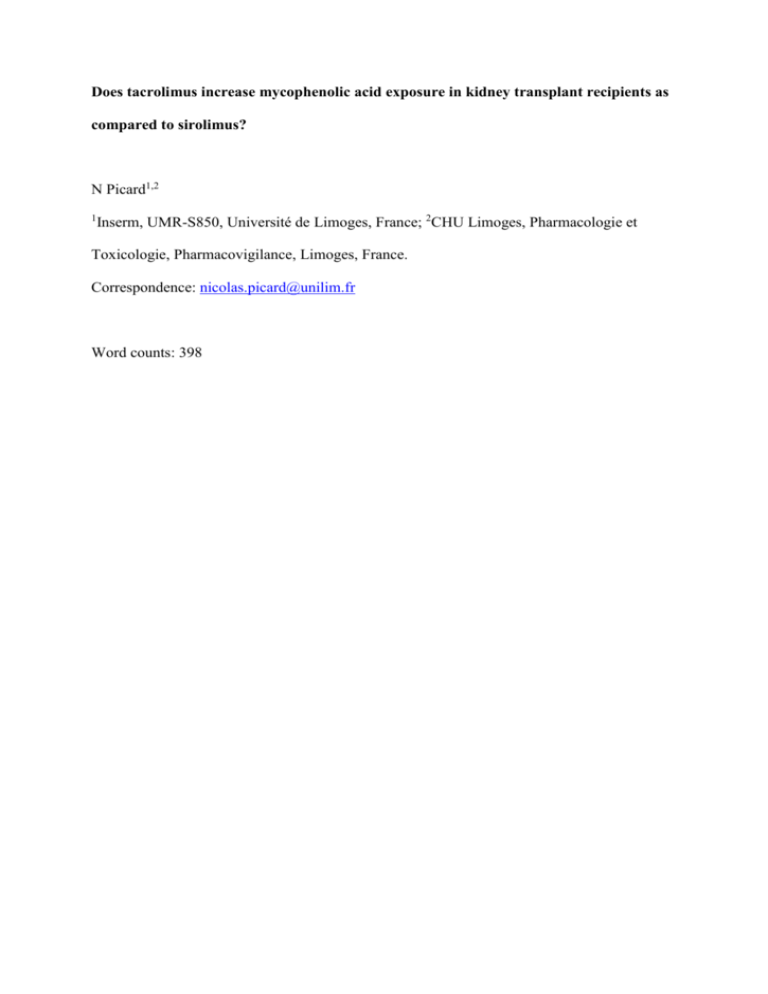
Does tacrolimus increase mycophenolic acid exposure in kidney transplant recipients as compared to sirolimus? N Picard1,2 1 Inserm, UMR-S850, Université de Limoges, France; 2CHU Limoges, Pharmacologie et Toxicologie, Pharmacovigilance, Limoges, France. Correspondence: nicolas.picard@unilim.fr Word counts: 398 To the Editor: Based on their study, “Increased mycophenolic acid exposure in stable kidney transplant recipients on tacrolimus as compared with those on sirolimus: implication for pharmacokinetics”, Braun et al. concluded that mycophenolic acid (MPA) exposure is greater in tacrolimus treated patients than in those treated with sirolimus during maintenance immunosuppression after kidney transplant and suggested that it may reflect an intestinal interaction of tacrolimus and MPA (1). Knowledge of whether MPA exposure is differentially modified by tacrolimus and sirolimus is important because of the current clinical trend of substituting calcineurin inhibitors for mTOR inhibitors and of the growing evidence that MPA exposure should be controlled to optimize therapy. However, given the interindividual pharmacokinetic variability of MPA, we feel that the number of patients studied by Braun et al. (n=9 on sirolimus vs 14 on tacrolimus) was too low to rigorously demonstrate a pharmacokinetic interaction. We recently conducted a pharmacogenetic/pharmacokinetic study of MPA in a larger group of kidney transplant recipients and found no difference of MPA and MPA-glucuronide dose-normalized exposures between patients on sirolimus (n=42) and tacrolimus (n=28), with similar renal function (2) (Table 1). Braun et al. suggested that MPA was better absorbed in the gastrointestinal tract when associated with tacrolimus than with sirolimus and argued that recent clinical findings from Mino et al. (3) and experimental data involving an ex-vivo swine intestinal perfusion model (4) supported their hypothesis. In fact, in the perfusion model tacrolimus resulted in higher amounts of MPA-glucuronide with no reported change in MPA, which rather suggests that tacrolimus decreases MPA oral bioavailability. Conversely, a well-designed drug interaction study in rats showed that MPA concentrations during monotherapy are not different from concentrations detected during tacrolimus coadministration, which is not in favour of an interaction (5). On the other hand, the study from Milo et al. compared MPA pharmacokinetics between kidney transplant recipients and patients with lupus nephritis receiving no calcineurin inhibitors but high doses of glucocorticoids, which makes any extrapolation to other situations very hazardous. The alternative hypothesis of ‘unknown’ protein-protein interaction raised by Braun et al. seems very speculative. The conclusions drawn by Braun et al. about the interaction between mycophenolate and tacrolimus appear thus to be conflicting with experimental findings as well as with observations in a larger population. However, the definitive proof can only be brought by a randomized cross-over clinical pharmacokinetics study in homogenous groups of transplant recipients. Table 1: Comparison of mycophenolic acid pharmacokinetics associated with sirolimus and tacrolimus comedication in renal transplant recipients at 3 to 6 months post transplant. Dose normalized Sirolimus (n=42) Tacrolimus (n=28) P parameter MPA AUC0-12h (mg.h/l)/g 64.6±34.7 66.0±29.7 0.6401 Cmax (mg/l)/g 20.1±9.4 27.2±21 0.2674 Cmin (mg/l)/g 4.4±3.5 3.9±2.5 0.6958 AUC0-9h (mg.h/l)/g 1011±595 1183±611 0.1220 Cmax (mg/l)/g 152±84 177±95 0.2059 Cmin (mg/l)/g 99±75 108±59 0.3436 MPA-glucuronide The pharmacokinetic parameters are shown as mean values±SD. AUC, area under the curve; Cmax, peak plasma concentration; Cmin, trough plasma concentration; MPA, mycophenolic acid. Details on patient characteristics given in (2). References (1) Braun, F., Schocklmann, H., Ziegler, E., Kunzendorf, U., Armstrong, V.W. & Renders, L. Increased mycophenolic acid exposure in stable kidney transplant recipients on tacrolimus as compared with those on sirolimus: implications for pharmacokinetics. Clin. Pharmacol. Ther. 86, 411-415 (2009). (2) Picard, N. et al. The role of organic anion-transporting polypeptides and their common genetic variants in mycophenolic acid pharmacokinetics. Clin. Pharmacol. Ther. 87, 100-108 (2010). (3) Mino, Y. et al. Comparison of pharmacokinetics of mycophenolic acid and its glucuronide between patients with lupus nephritis and with kidney transplantation. Ther. Drug Monit. 30, 656-661 (2008). (4) Braun, F. et al. An ex vivo model to study the intestinal biotransformation of immunosuppressives. Transplant Proc. 32, 2536 (2000). (5) van Gelder, T., Klupp, J., Barten, M.J., Christians, U. & Morris, R.E. Comparison of the effects of tacrolimus and cyclosporine on the pharmacokinetics of mycophenolic acid. Ther. Drug Monit. 23, 119-128 (2001).
